Alocasia Care: How to Grow Alocasia Plants (Including Alocasia Types With Pictures)
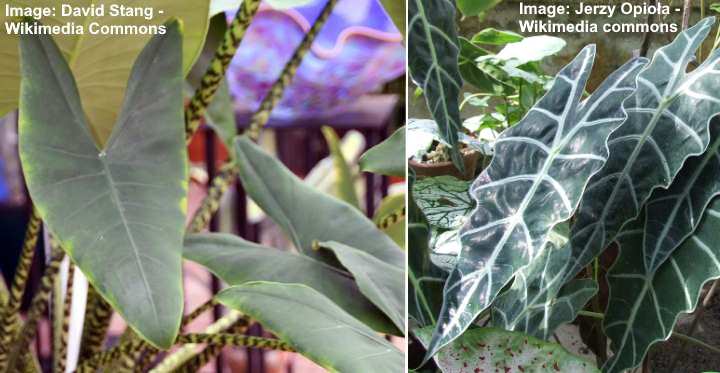
Alocasia is a genus of tropical plants that have spectacular large arrowhead leaves and glossy green foliage. Popular types of Alocasia such as the African Mask plant (Alocasia amazonica ‘Polly’) and Elephant Ears ‘Tiger’ (Alocasia zebrina) are ideal houseplants. Alocasia plants thrive indoors in warm, bright indirect light, growing in moist soil.
Although Alocasia plants are a flowering plant species, it’s their impressive leaves and dramatic foliage that make them popular. The African Mask plant (Alocasia amazonica), also called Kris plant, has striking dark green triangular leaves with pronounced creamy-white veins. The Alocasia zebrina, also called Alocasia Leopard, has green arrow-shaped leaves with unusual and unique patterned arching stems with zebra-like patterns.
However, there are many Alocasia hybrids, each with their own unique characteristics. At the end of this article, you’ll find out more about eight stunning examples of Alocasia plants.
Facts About Alocasia Plants
Alocasia plants are native to warm, tropical forests and jungles where they grow on the forest floor. Species of Alocasia don’t survive cold winters or dry, arid conditions. However, they grow well in pots indoors as long as they get enough light and humidity.
Most Alocasia species are large perennial tropical plants with huge leaves. For example, the large Night-Scented Lily (Alocasia odora) or Alocasia ‘Mayan Mask’ grow between 4 and 8 ft. (1.2 – 2.4 m) tall.
However, the Alocasia hybrid Amazonian Elephant Ear (Alocasia amazonica) and the smaller cultivar ‘Polly’ only grow between 1 and 3 ft. (0.3 – 1 m) tall. Similarly, the Alocasia zebrina ‘Tiger’ doesn’t usually grow taller than 3 ft. (1 m).
Because Alocasia species come from the tropics, they only grow outdoors in USDA zones 10 through 12.
Care and Growing Guide for Alocasia Plants
All species of Alocasia plants thrive in bright indirect light, growing in a loose potting mix with excellent drainage. Water the Alocasia plants often enough to keep the plant roots slightly moist, and mist the leaves daily to increase humidity to encourage lush, healthy foliage.
Alocasia plants’ temperature range is between 60°F and 82°F (15°C – 28°C). These fast-growing houseplants need fertilizing during the growing season.
Light Requirements for Growing Alocasia Plants Indoors
Alocasia plants grow best in a bright, sunny room but protected from direct sunlight. Plenty of light encourages healthy growth and ensures that the vibrant foliage keeps its color. The best location for Alocasia plants is near an east- or west-facing window. In a south-facing room, keep the plant about 5 ft. (1.5 m) from the window or protect it behind a sheer curtain.
Houseplants such as the Alocasia ‘Polly,’ Tiger Alocasia, or Alocasia ‘Frydek’ are not plants that grow well in shade or dark rooms. Insufficient light will cause their growth to slow down. Also, the leaves will lose their color, turn yellow, and eventually die.
The Best Soil for Alocasia Houseplants
Grow species of Alocasia in porous soil that has excellent drainage. An ideal ‘alocasia soil’ mix would be equal parts of houseplant soil, peat moss, and perlite. These potting mix ingredients hold just enough moisture and provide excellent drainage. While Alocasia plant roots need moist soil, they don’t like soggy, damp conditions.
Getting the soil mix right is a critical care factor for Alocasia houseplants. If the soil holds too much moisture, the tuberous roots can quickly rot and decay.
The combination of peat moss and perlite or poultry grit helps provide nutrients without too much moisture. Peat moss is ideal as a fertile soil amendment to encourage healthy growth. Inorganic matter such as crushed gravel, pumice, or perlite helps water drain fast through the potting mix.
How to Water Alocasia Plants
Alocasia plants need watering often enough to keep the soil evenly moist. The best way to know if your broad-leafed Alocasia needs water is when the top 0.5” to 1” (1 – 2.5 cm) is dry. Provide enough water to keep the soil evenly moist. Alocasia plants don’t like dry, arid soil, and they die if the soil is too soggy.
Alocasia plants are more temperamental than other houseplants. Typically, with other indoor plants, soaking the soil and letting it dry partially is usually the best plant watering method. But with Alocasia plants, it seems that watering little and often is the best way to keep the soil moisture levels right.
It’s good to remember that Alocasia plants enter a period of dormancy. During the dormant winter period, growth almost stops, and some vegetation can die off. So it would be best if you only watered Alocasia amazonica and Alocasia zebrina in winter when the top 2” (5 cm) of soil is dry.
Temperature Range for Alocasia Plant Care
Alocasia plants such as Alocasia reginula, Alocasia macrorrhiza ‘Stingray,’ and Alocasia baginda ‘Silver Dragon’ thrive in warm rooms. Their ideal temperature range is 65°F to 80°F (18°C – 27°C) for fast, vibrant growth. The minimal temperature for Alocasia plants is 60°F (15°C). It’s vital to remember that cold temperatures can kill these warm-loving plants.
Alocasia plants thrive outdoors in USDA zones 10 through 12. You can take your potted alocasias outside in the warm summer months. These plants can add a tropical feel to your patio, deck, or balcony. However, it’s vital to keep the potted plants out of direct sunlight and cold drafts.
Humidity Requirements for Alocasia Plants
Alocasia plants require humidity of between 50 and 60 percent to thrive indoors. Typically, household air is too dry for these moisture-loving plants. To encourage healthy growth, mist the Alocasia leaves daily, use a room humidifier, or place the pot on a pebble tray half filled with water to increase humidity.
How to Fertilize Alocasia Plants
Alocasia zebrina, Alocasia amazonica, and other Alocasia houseplant varieties benefit from extra fertilization during the growing season. From spring until late summer, apply a diluted houseplant fertilizer every two weeks. Or you can use a slow-release plant fertilizer to encourage healthy growth.
Chemical houseplant fertilizers tend to cause a buildup of mineral salts in the potting soil. If you water your plant with tap water, then other chemicals could also affect Alocasia plant growth.
To help keep your Alocasia plants growing well, use natural, organic houseplant fertilizers. These don’t leave behind chemicals that can cause root burn. When watering your plants, leave water out overnight in a jar to let the chemicals evaporate and bring the water up to room temperature.
How to Repot an Alocasia Plant
Alocasia plants don’t need repotting often. These plants in the genus Alocasia tend to grow well in pots when they are slightly rootbound. In fact, sometimes repotting an Alocasia plant too often can stress the plant and cause drooping growth for a while.
To repot an African Mask Plant or Tiger Alocasia, always choose a pot one size up from its current one. Use an appropriate soil mix for alocasias and transfer the plant to its new, larger container.
While repotting, check the roots for signs of decay or damage. If you have a large Alocasia, such as the Alocasia amazonica, Alocasia macrorrhiza ‘Stingray,’ or Alocasia macrorrhizos ‘Giant Taro,’ repotting is an excellent time to propagate a new plant.
Propagating Alocasia Plants
Alocasia plants are propagated by root division or separating the plantlets. Alocasia plants have tuberous rhizome roots that you can cut into sections to grow new plants. Or sometimes you will see small ‘baby’ plants growing near the plant’s base. You can cut these off and plant them in a new pot.
When propagating Alocasia plants, it’s vital to remember to keep them in a warm and humid environment. Also, don’t be worried if the plant growth seems somewhat slow after propagation. The alocasias should come back to life after a few weeks.
Do Alocasia Plants Need Pruning?
It’s rarely necessary to prune Alocasia plants. Old leaves turn brown and die off as new leaves appear on the plant. However, you can trim yellowing or dead leaves to improve the plant’s appearance.
Pests Affecting Alocasia Plant Growth
The most common houseplant pests to affect Alocasia plants are mealybugs and spider mites. Use a natural neem oil spray to get rid of these nasty creatures. All you need to do is combine 2 tsp. neem oil, a few drops of liquid dish soap, and a quart (1 l) of warm water in a spray bottle. Liberally spray the foliage weekly to help remove the pests.
Proper plant care is vital to prevent houseplant bugs from infesting your prized alocasias. Pests are attracted to weak Alocasia plants that don’t get enough sunlight, have too little moisture, or are overwatered.
What Diseases Affect Alocasia Plants?
Root rot can affect any species of Alocasia if you overwater the potting soil. Make sure that the soil is evenly moist but never waterlogged, soggy, or too damp. The tuberous roots can quickly start to decay if they grow in overly-damp soil.
If you notice signs of overwatering—yellowing leaves and drooping growth—hold off watering until the top 1” to 2” (2.5 – 5 cm) of soil is dry. However, if your Alocasia doesn’t come back to life, you can try to repot the plant in a fresh potting mix. Cut off any dead parts of the root before replanting.
However, if the rot is extensive, you may have to discard the plant.
Are Alocasia Plants Toxic?
All plants in the genus Alocasia are poisonous for cats, dogs, other animals, and humans. According to the ASPCA, Alocasia species contain toxins that can cause oral swelling and digestive upset if ingested. So, keep these plants away from pets or children if you have them at home.
FAQ About Growing Alocasia Indoor Plants
Why do Alocasia plant leaves turn brown?
Alocasia plant leaves that turn brown are usually a sign of insufficient humidity. To prevent brown patches from appearing on leaves, mist the leaves daily to increase humidity. Sometimes, old leaves turn brown before dropping off. This is natural, and you should notice new leaves growing in their place if your plant is healthy.
Why Alocasia leaves turn yellow
Overwatering an Alocasia plant is usually the reason leaves turn yellow. However, too much direct sunlight, cold drafts, pest infestation, or a lack of nutrients can also be to blame for yellow Alocasia leaves. It’s vital to identify the cause of yellow leaves and rectify the issue.
What are the reasons for water drops on Alocasia leaves?
Sometimes you may notice a drop of water on the tips of Alocasia leaves which usually indicates that the potting soil is slightly too moist. However, drops on leaves are nothing to worry about as the plant is “sweating” to get rid of excess moisture.
How long is Alocasia dormancy?
All species of Alocasia plants have a dormant period during winter. During this time, it’s vital only to give the plants minimal water and not fertilize them. Alocasia dormancy ends in spring when life returns to this tropical plant species.
Why Alocasia plants have drooping leaves
Drooping foliage on Alocasia plants is often a sign of under-watering. To help revive the plant, give it a good watering and ensure that the soil stays slightly moist. Letting the soil dry somewhat between watering can help Alocasia plants maintain proper, robust growth.
However, insufficient light, pests, or a nutrient deficiency in the soil can also result in drooping Alocasia plant growth.
Species of Alocasia Plants
Let’s look at some of the identifying features and characteristics of popular Alocasia plants. Some of these tropical plants are ideal as houseplants, whereas others grow well in large greenhouses.
Here are some of the most amazing varieties of Alocasia plants.
Alocasia Amazonica
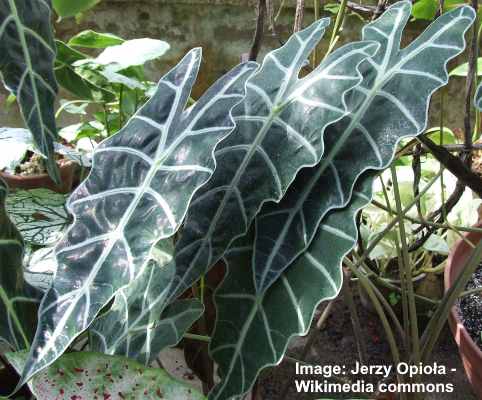
Alocasia amazonica
Alocasia amazonica is a stunning perennial houseplant with dramatic foliage. The Elephant Ear’s plant has large, dark-green arrowhead leaves with striking white or light green veins and wavy edges. Alocasia amazonica grows up to 3 ft. (1 m) tall, and its eye-catching leaves can be 2 ft. long. This Alocasia species thrives in warm, bright, humid conditions.
Alocasia Amazonica ‘Polly’

Alocasia amazonica ‘Polly’
Also called the African Mask plant, the Alocasia amazonica ‘Polly’ is a small cultivar that is perfect for growing indoors. The compact Alocasia plant has stunning glossy green leaves with greenish-white pronounced veins. Another feature of the arrow-like leaves is their wavy edges, similar to a kris or keris dagger—hence the other name ‘Kris’ plant.
Read our comprehensive care guide to Alocasia amazonica ‘Polly’.
Alocasia Zebrina
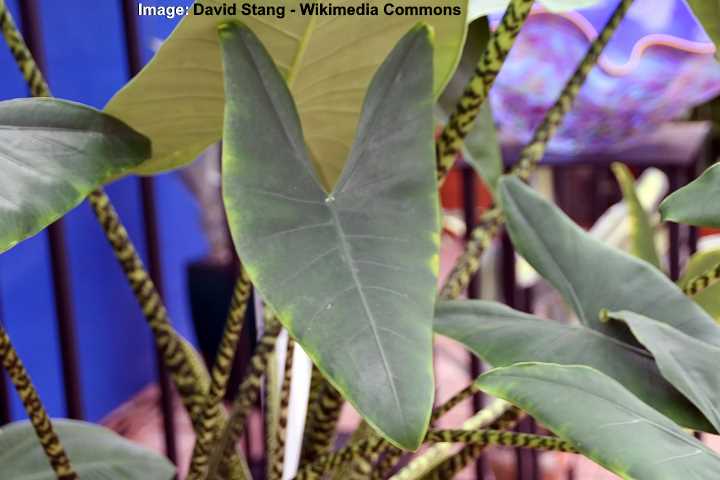
Alocasia zebrina
Alocasia zebrina is a tropical houseplant that has eye-catching long arching stems with animal-like patterns. The dark green stems have creamy-white or light green markings, which are the outstanding feature of this plant. Alocasia zebrina is also called the Tiger Alocasia, Alocasia ‘Leopard,’ or Alocasia ‘Tiger.’ Like other Alocasia houseplants, grow this cultivar in bright, warm conditions with plenty of humidity.
Find out how to care for Alocasia zebrina.
Alocasia Odora
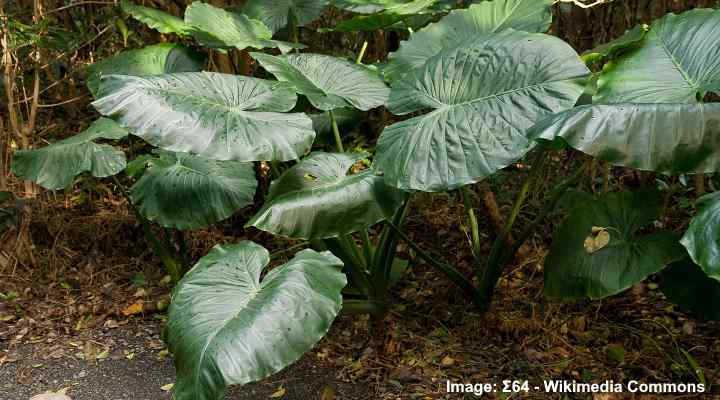
Alocasia odora
Also called the Night-Scented Lily, the Alocasia odora is a breathtakingly stunning plant with huge paddle-shaped leaves. The large leaves grow up to 2 ft. (0.6 m) long and 1 ft. (0.3 m) wide. Due to the size and shape of the leaves, this plant is also called the Giant Upright Elephant Ear plant. A feature of this Alocasia species is the pleasant fragrance it emits at night.
Alocasia Micholitziana ‘Frydek’
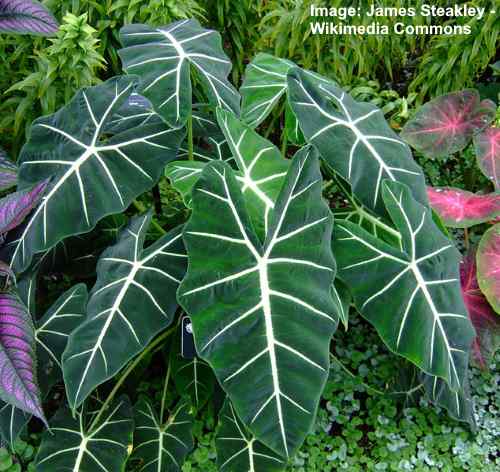
Alocasia micholitziana ‘Frydek’
The Alocasia ‘Frydek’ is a houseplant species that looks like the Alocasia amazonica but with velvety looking leaves rather than glossy ones. This Alocasia plant’s features are slender, arrow-shaped leaves with whitish veins, giving the foliage an attractive look. Alocasia ‘Frydek’ grows between 2 and 3 ft. (0.6 – 1 m) tall.
Alocasia Calidora
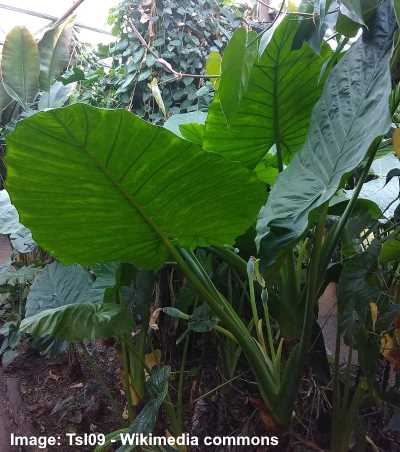
Alocasia calidora
The Alocasia calidora, or Persian Palm, is a tropical plant with huge dark green leaves. This Alocasia species has upright growth. The ‘Calidora Elephant Ear’ plant has leaves that can be 6 ft. (2 m) long and 3 ft. (1 m) wide. Overall, the Alocasia calidora can grow between 5 and 9 ft. (1.5 – 2.7 m) tall.
Alocasia Macrorrhiza var. ‘Lutea’
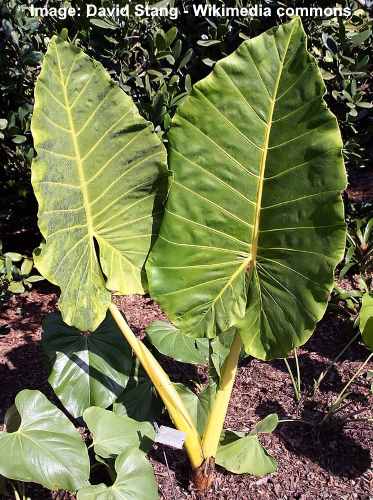
Alocasia macrorrhiza ‘Lutea’
The Golden Lutea Elephant Ear plant is a massive Alocasia plant species with thick yellow stalks, lime green leaves, and yellowish veins. Alocasia ‘Lutea’ is often called ‘Golden Lutea’ due to its golden yellow stems. The plant’s leaf shape is typical of many Alocasia species—shaped like an arrow’s head with pronounced veining.
Alocasia Macrorrhiza ‘Stingray’
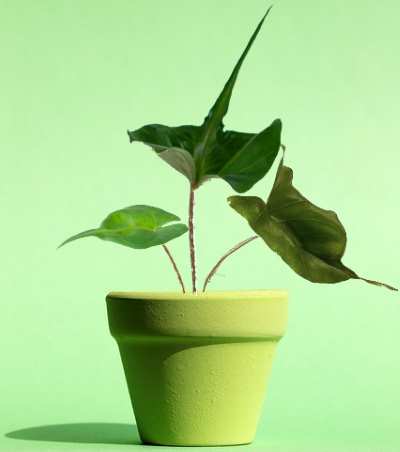
Alocasia macrorrhiza ‘Stingray’
The fascinating ‘Stingray’ Alocasia species has rippled, oval leaves and a long tip, making the leaves look like a stingray. The unusual houseplant grows up to 3 ft. (1 m) tall and thrives in warm, bright, humid conditions.
Related articles:
